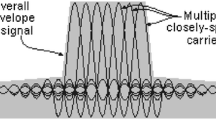Abstract
A new signal scrambling technique is proposed to minimize the peak to average power ratio (PAPR) of multi carrier code division multiple access (MC-CDMA) signal using novel detected peak samples combining technique. This new approach minimizes PAPR by combing the MC-CDMA symbol with a number of copies of the detected peak sample which belong to the same MC-CDMA symbol. The analytical and simulation results show that by the right selection of the number of peak samples; the PAPR for 64 subcarrier system reduces by 4.9 dB at the complementary cumulative distribution function = 10−3. The PAPR can be further reduced by increasing the number of peak samples but it could compromise the data speed. The implementation of this technique is very simple when compared to the existing techniques like selective mapping, partial transmit sequence and tone reservation as it requires lesser number of Inverse Fast Fourier Transform/Fast Fourier Transform blocks, no side information and low processing delay.





Similar content being viewed by others
References
Hara, S., & Prasad, R. (1997). Overview of multi-carrier CDMA. In Proceedings of IEEE 4th communication magazine (Vol. 35, pp. 126–133).
Abdullah, M. F. L., Ghanim, M. F., & Yonis, A. Z. (2013). Effect of FFT size on PAPR of MC-CDMA system. In 9th IEEE international colloquium on signal processing and its application (pp. 182–187). Kuala Lumpur, Malaysia.
You, Y.-H., Jung, H.-K., & Jeon, W.-G. (2004). A simple peak-to-average power ratio (PAR) reduction scheme for OFDM-CDMA signals. International Journal of Electronics and Communications (AEÜ), 58(2), 142–146.
Bauml, R. W., Fischer, R. F. H., & Huber, J. B. (1996). Reducing the Peak-to-Average power ratio of multicarrier modulation by selected mapping. IEEE Electronic Letters, 32(2), 2056–2057.
Sudha, V., Anilkumar, B., & Sriramkumar, D. (2015). Low-complexity modified SLM method for PAPR reduction in OFDM system. In IEEE sponsored 2nd international conference on electronics and communication system ICECS (pp. 1324–1328).
Ryu, H. G., & Youn, K.-J. (2002). A new PAPR reduction scheme SPW. IEEE Transaction on Consumer Electronics, 48(1), 81–88.
Hieu, N. T., Kiom, S.-W., & Ryu, H.-G. (2005). PAPR reduction of low complexity phase weighting method in OFDM communication system. IEEE Transaction on Consumer Electronics, 51(3), 776–782.
Yoga, S. W., Suryani, T., & Suwadi. (2016). Application PTS technique for PAPR reduction in MIMO OFDM using WARP. In IEEE international seminar on intelligent technology and application (pp. 317–322).
Dhungana, H., Sah, S. K., & Shakya, S. (2012). Performance evaluation of PAPR reduction in multicarrier system by PTS and SLM methods. In IEEE third Asian Himalayas international conference on internet (pp. 1–5).
Khatri, A. K., & Tharani, L. (2015). An approach to compare the developments in performance of Multicarrier CDMA system. In IEEE international conference ICCCA 2015 (pp. 1226–1231).
Namitha, A. S., & Sameer, S. M. (2015). A novel joint method for frequency offset estimation and Peak-to-Average Power Ratio Reduction in OFDM system using Null subcarriers. Wireless Personal Communication. https://doi.org/10.1007/s11277-015-2396-0.
Yang, L., Siu, Y. M., Soo, K. K., Leung, S. W., & Li, S. Q. (2012). Low-complexity PAPR reduction technique for OFDM system using modified widely linear SLM scheme. International Journal of Electronics and Communications (AEÜ), 66, 1006–1010.
Adegbite, S. A., McMeekin, S. G., & Stewart, B. G. (2016). A low complexity SI sequence estimator for pilot-aided SLM-OFDM systems. International Journal of Electronics and Communications (AEÜ), 70(9), 1267–1274.
Fallahzedeh, M., & Ferdosizadeh, M. (2017). Blind SLM for PAPR reduction of Alamouti DSFBC systems. IET Communications Journals, 11(3), 451–457.
Yang, L., Chen, R. S., Soo, K. K, & Siu, Y. M. (2007). An efficient sphere decoding approach for PTS assisted PAPR reduction of OFDM signals. International Journal of Electronics and Communications (AEÜ), 61(10), 684–688.
Sampath Kumar, C., & Hari Krishna Prasad, P. (2016). APPR combined PTS Technique for reduction of PAPR in OFDM system. In IEEE international conference on advanced communication control and computing technologies (ICACCCT) (pp. 158–161).
Feng, Z., Liu, W., Tao, X. & Zhang, J. (2011). PAPR reduction of OFDM using novel concatenated PS-PTS method. In IEEE 7th international conference on wireless communications, networking and mobile computing (pp. 1–4).
Muller, S. H., & Huber, J. B. (1997). A novel peak power reduction scheme for OFDM. In 8th IEEE international symposium on personal, indoor and mobile radio communication.
Krongold, B. S., & Jones D. L. (2003). PAR reduction in OFDM via active constellation extension. IEEE Transactions on Broadcasting, 49, 258–268.
Vallavaraj, A., Stewart, B. G., & Harrison, D. K. (2010). An evaluation of modified µ-law companding to reduce the PAPR of OFDM system. International Journal of Electronics and Communications (AEÜ), 64, 844–857.
Wang, Y., Ge, J., Wang, L., & Lee, J. (2013). Reduction of PAPR of OFDM signals using nonlinear companding transform. Wireless Personal Communication, 71(1), 383–397.
Li, X., & Cimini, L. J. (1998). Effect of clipping and filtering on the performance of OFDM. IEEE Communication Letters, 2(5), 131–133.
Hemmati, R. A., Azmi, P., & Marvasti, F. (2010). Joint multi-user interference and clipping noise cancellation in uplink MC-CDMA system Ratio. International Journal of Electronics and Communications (AEÜ), 64, 425–432.
Hu, W.-W. (2016). PAPR Reduction for Pilot-aided OFDM systems with the parametric minimum cross-entropy method. International Journal of Electronics and Communications (AEÜ), 70, 367–371.
Xia, J., Li, Y., & Zhang, Z. (2013). A suboptimal TR algorithm with fixed phase rotation for PAPR reduction in MC-CDMA system. In IET International Conference on Information and Communication Technologies (IETICT2013) (pp. 415–420).
Author information
Authors and Affiliations
Corresponding author
Additional information
Publisher's Note
Springer Nature remains neutral with regard to jurisdictional claims in published maps and institutional affiliations.
Rights and permissions
About this article
Cite this article
Khatri, A.K., Tharani, L. A Novel Detected Peak Samples Combining Technique for PAPR Minimization of MC-CDMA Signal. Wireless Pers Commun 108, 2449–2460 (2019). https://doi.org/10.1007/s11277-019-06532-6
Published:
Issue Date:
DOI: https://doi.org/10.1007/s11277-019-06532-6




